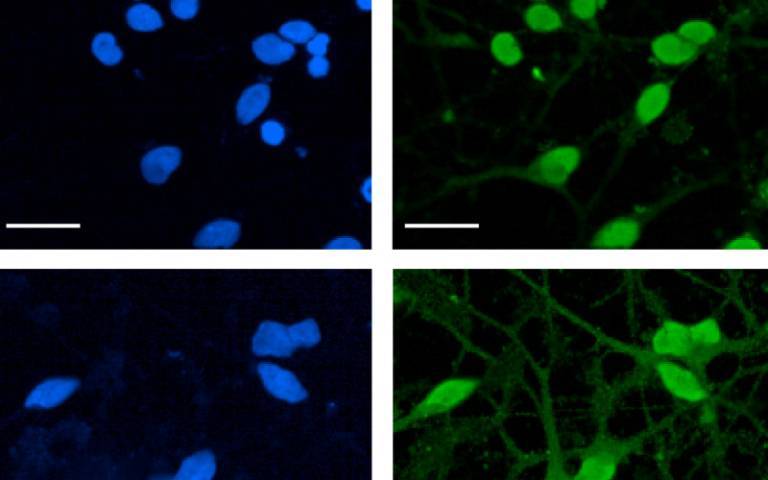Scale of disorder underpinning Motor Neuron Disease much larger than previously thought
23 July 2023
Hundreds of proteins and mRNA molecules are found in the wrong place in nerve cells affected by Motor Neuron Disease (MND), finds a new study by researchers at UCL Queen Square Institute of Neurology and the Francis Crick Institute.

The condition, also known as Amyotrophic Lateral Sclerosis (ALS), is a rapidly progressing and devastating condition that causes paralysis by affecting motor neurons, with limited treatment options.
Until now, scientists were aware that a few proteins, especially a protein called TDP-43, were found in unexpected locations in ALS nerve cells.
However, the new research, published in Neuron, shows that the problem is much broader. This ‘mislocalisation’ affects many more proteins than first thought, especially those involved in RNA binding (a process important for gene expression).
The mislocalisation extends to mRNAs too, molecules that deliver instructions to make proteins from the DNA in the nucleus.
The researchers used stem cells from patients to create motor neurons with ALS-causing mutations in the TARDBP and VCP genes. They then separated the two main compartments of the cell (nucleus and cytoplasm), and analysed all the mRNA and protein within each. They found that in ALS cells, hundreds of mRNAs and proteins were mislocated compared to healthy cells.
They observed proteins and mRNAs relocating from the cell’s nucleus (its ‘control centre’) into the cytoplasm (the ‘body’ of the cell) or vice versa, hinting at potential transport issues within the cell.
The researchers also saw that mislocated mRNAs and proteins interacted more with each other, compared to those in the right place. They speculate that as the mRNAs and proteins mislocalise, they may drag each other with them, creating a domino effect.
Professor Rickie Patani (UCL Queen Square Institute of Neurology, the Crick and National Hospital for Neurology and Neurosurgery, UCLH), said: “For the patients I see, it’s devastating that there aren’t yet impactful treatments available for ALS. This research represents a shift in our thinking about what causes ALS – it doesn’t involve abnormal movement of just a few proteins, but the abnormal localisation of hundreds of proteins and mRNAs. This opens new avenues for research and potential therapies.”
Remarkably, the mislocation of proteins and mRNAs was partially improved with a drug called ML240, which blocks the action of the VCP enzyme. Blocking this enzyme also led to other beneficial effects on cell function, such as reducing the levels of damage to DNA.
Professor Rickie Patani said: “As ML240 improved the mislocalisation and other disease features in ALS, we now need to understand if this can be a tractable therapy for ALS more widely. This is just the beginning and there is lots more to do, but our work provides some hope for effective therapies.”
Dr Oliver Ziff (UCL Queen Square Institute of Neurology, the Crick and UCLH), said: “We were surprised to see the extent of the mislocalisation, particularly for mRNAs, as this hasn’t been reported before.
“The goal now is to find where this problem starts and there are many intriguing possibilities – one being a breakdown in the transport between the nucleus and cytoplasm.
“This study was an exception team effort, and I’m immensely grateful to my colleagues, particularly co-first authors, Drs Jasmine Harley, Yiran Wang and Jacob Neeves.”
The researchers will next investigate protein and mRNA location in other ALS genetic backgrounds. There is also much more work ahead before VCP inhibitors could be used clinically – ML240 hasn’t yet been tested in animals, and potential chemical changes may be necessary to make sure it enters nerve cells without causing side effects.
Links
- Oliver J. Ziff, et al. Nucleocytoplasmic mRNA redistribution accompanies RNA binding protein mislocalization in ALS motor neurons and is restored by VCP ATPase inhibition. Neuron, 2023, DOI: 10.1016/j.neuron.2023.06.019. Available online 21st July 2023.
- Professor Rickie Patani's academic profile
- Oliver Ziff's academic profile
Source
Image
'Compared to control (top row), in the ALS neuron (bottom row) the FUS protein (green) has moved out of the nucleus (blue) into the rest of the neuron (the long green strands in the bottom right). Image credit: Dr Yiran Wang
 Close
Close

